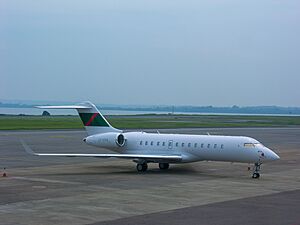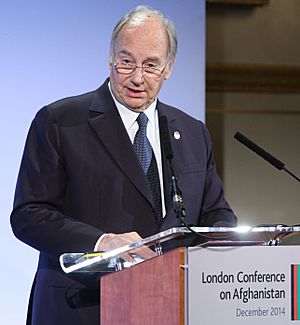Aga Khan IV facts for kids
Quick facts for kids
Prince Karim Aga Khan IV
|
|
|---|---|
| آقاخان چهارم | |
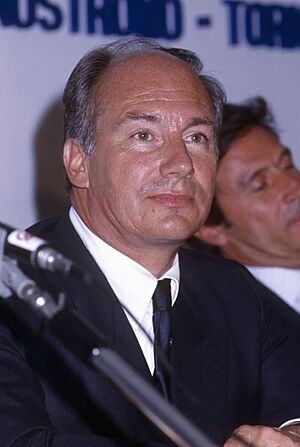
Aga Khan IV in 1985
|
|
| Citizenship | United Kingdom France Switzerland Portugal Canada |
| Education | Harvard University (BA) |
| Title | Aga Khan IV |
| 49th hereditary Imam of Nizari Isma'ilism Muslims | |
| Tenure | 11 July 1957 – 4 February 2025 |
| Installation | 19 October 1957 |
| Predecessor | Aga Khan III |
| Successor | Aga Khan V |
| Born | Shāh Karim al-Hussaini 13 December 1936 Geneva, Switzerland |
| Died | 4 February 2025 (aged 88) Lisbon, Portugal |
| Burial | 9 February 2025 Mausoleum of Aga Khan, Aswan, Egypt |
| Spouse |
Sarah Croker Poole
(m. 1969; div. 1995)Gabriele Homey
(m. 1998; div. 2011) |
| Issue |
|
| House | Fatimid |
| Father | Prince Aly Khan |
| Mother | Princess Taj-ud-dawlah |
| Religion | Nizari Isma'ilism Shia Islam |
| Occupation | Imam (spiritual leader) Philanthropist Businessman Socialite |
Prince Karim al-Husseini (born December 13, 1936 – died February 4, 2025), known as the Aga Khan IV, was the 49th spiritual leader, or Imam, of the Nizari Isma'ili Muslims. He became Imam in 1957 at the age of 20, after his grandfather, the Aga Khan III, passed away. His followers also called him Mawlānā Hazar Imam.
The Aga Khan IV was a very wealthy person. In 2013, his net worth was estimated to be over US$13.3 billion. He was listed among the world's richest royals, even though he did not rule any country or territory. His role was as the hereditary Imam of the Nizari Ismailis. He founded and led the Aga Khan Development Network (AKDN), which is one of the largest private organizations working to improve lives around the world. He was also a successful businessman, owning racehorses and breeding operations. He held citizenship in the UK, France, Switzerland, Portugal, and Canada (honorary).
Contents
Early Life and Education
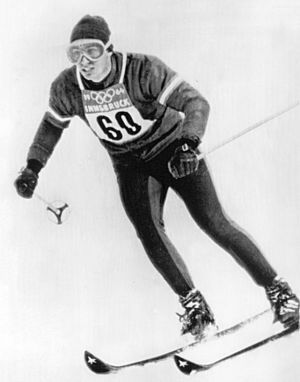
Karim al-Husseini was born in Geneva, Switzerland, on December 13, 1936. He was the oldest son of Prince Aly Khan and his first wife, Princess Taj-ud-dawlah Aga Khan (formerly Joan Yarde-Buller). His mother was the daughter of a British nobleman.
He spent his early childhood during World War II in Nairobi, Kenya, where he was taught by private tutors. Later, he attended the Institut Le Rosey in Switzerland for nine years. He then went to Harvard University to study Islamic history, even though he had wanted to study science at MIT. His grandfather, the Aga Khan III, wanted him to study history instead.
When his grandfather passed away in 1957, Karim al-Husseini was still a university student. He had to put aside his plans for more studies to take on his new duties as Imam. He graduated from Harvard in 1959 with a degree in history. He was also a competitive downhill skier, representing Great Britain and then Iran in the 1964 Winter Olympics.
Becoming the Nizari Ismaili Imam
When his grandfather, the Aga Khan III, died, Karim al-Husseini became the 49th Imam of the Nizari Ismailis and Aga Khan IV. He was only 20 years old. His grandfather chose him over his father and uncle. In his will, his grandfather explained why he chose a young successor:
"The world has changed a lot, with new discoveries like atomic science. I believe it's best for the Nizari Ismaili community to have a young leader. Someone who grew up in this new age and brings fresh ideas to the role."
Because of this, some Nizari Ismailis called him the "Imam of the Atomic Age". His grandfather's will also said that the new Aga Khan should seek advice from his grandmother, Begum Om Habibeh Aga Khan, for general matters.
Leading the Nizari Ismaili Community
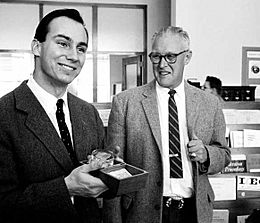
When he became Imam, al-Husseini wanted to continue his grandfather's work. He aimed to build modern organizations to help the Nizari Ismaili community. Ceremonies were held around the world from 1957 to 1958 to mark his installation. During these events, he spoke about the importance of different groups and faiths working together. He encouraged better relationships between communities in East Africa and India.
In 1972, many people of South Asian origin, including Nizari Ismailis, were forced to leave Uganda. The Aga Khan IV called his friend, Canadian Prime Minister Pierre Trudeau. Trudeau's government allowed thousands of Nizari Ismailis to move to Canada. The Aga Khan IV also helped Ismailis displaced from Uganda, Tanzania, Kenya, and Burma find new homes in other countries. Most of them settled in Asia, Europe, and North America. They quickly adapted due to their education and community support.
The Aga Khan IV encouraged Ismailis in developed countries to support projects in areas with large Ismaili populations. He believed the Imam's role included both explaining religious teachings and caring for the community's social well-being. He emphasized that Ismailis should also be involved in the wider societies where they live.
He was one of the Shia leaders who signed the 2004 Amman Message. This message helped define which Islamic groups are part of the larger Muslim community.
In 2006, during a controversy involving Pope Benedict XVI, he said: "I have two thoughts about the pope's speech: I'm worried about the worsening relationships, but I also see a chance. A chance to discuss a serious and important topic: how religion and logic connect."
When asked about alcohol in 1965, he said: "Our belief is that what makes humans different from animals is our ability to think. Anything that stops this thinking is wrong. So, alcohol is forbidden. I have never had alcohol. For me, this isn't a strict rule; I simply don't want to drink. My religion doesn't force me."
He was the first faith leader to speak to the Parliament of Canada in 2014.
Jubilee Celebrations
From 1982 to 1983, to celebrate his 25th year as Imam (Silver Jubilee), many new projects were started. These included the Aga Khan University in Karachi, Pakistan, with its health sciences faculty and hospital. Schools for girls and medical centers were expanded in the Hunza Valley in Pakistan. The Aga Khan Rural Support Programme was started in Gujarat, India. Existing hospitals and health centers in Tanzania and Kenya were also improved.
From 2007 to 2008, he celebrated his 50th year as Imam (Golden Jubilee). Representatives from Ismaili communities worldwide gathered at his home. He visited many countries, meeting leaders to discuss ongoing development work. He visited the Americas, Europe, Asia, and Africa. In Houston, Texas, he announced the creation of the Ismaili Center Houston.
In 2008, as part of the Golden Jubilee, he organized the Jubilee Games. This was a sports event in Kenya where Ismaili teams from different parts of the world competed. The games continued to be held later.
From 2017 to 2018, he celebrated his 60th year as Imam (Diamond Jubilee). He traveled to countries where his humanitarian organizations work. He launched new programs to help reduce poverty and improve access to education, housing, and child development. Many concerts and festivals were held. In 2018, he officially named the Henrique de Mendonça Palace in Lisbon, Portugal, as the "Diwan of the Ismaili Imamat." This became the main seat of the Ismaili Imamat.
Ismaili Constitution
In 1986, the Aga Khan IV created a constitution for the Nizari Ismaili community, which was updated in 1998. This document set up how the community would be governed and organized in different countries. It explained the Imam's role in religious and community matters, based on Islamic principles. The constitution aimed to provide a consistent and flexible framework for community practices worldwide.
Business Activities
Horse Racing
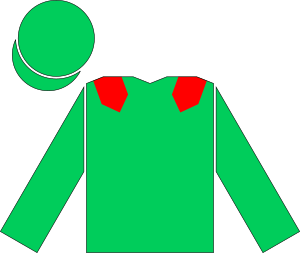
The Aga Khan IV's horse racing businesses earned a lot of money. He owned and ran large horse racing and breeding operations in France and Ireland. These included the French horse auction house, Arqana, and Gilltown Stud in Ireland.
He had a big horse racing and breeding operation at his estate, Aiglemont, in France. He bought many valuable horses and became a very influential owner and breeder in France. He won the French Oaks race many times.
His unbeaten filly, Zarkava, won a major race called the 2008 Prix de l'Arc de Triomphe in 2008. His colt, Harzand, won the 2016 Epsom Derby and the Irish Derby in 2016.
He was a main owner of Shergar, a famous Irish racehorse. Shergar was kidnapped in 1983. The Aga Khan IV and other owners refused to pay a ransom, and the horse was never found.
Other Businesses
The Aga Khan IV was involved in many other businesses, including media and luxury hotels. In 1959, he started the Kenyan media company Nation Media Group, which owns newspapers like Daily Nation.
Through his for-profit organization, AKFED, he was the largest shareholder in the Serena Hotels chain. These are luxury hotels mainly in Africa and Asia.
Other Activities
Aga Khan Development Network
The Aga Khan IV founded and led the Aga Khan Development Network (AKDN). This is a group of over 200 organizations that work mainly in developing countries. AKDN has about 80,000 staff members. It is funded by contributions from the Ismaili community and partnerships with governments and international groups. AKDN works in many areas, including health, education, culture, rural development, and economic growth. It focuses on regions in the Global South.
AKDN includes the Aga Khan University, the University of Central Asia, the Aga Khan Trust for Culture, and the Aga Khan Foundation. The Aga Khan Award for Architecture is the largest architecture award in the world. The Aga Khan IV also chaired the Board of Governors of the Institute of Ismaili Studies, which he founded in 1977.
Focus Humanitarian Assistance, part of AKDN, helps with emergency responses after disasters. They helped after the 2005 earthquake in Pakistan and the 2004 tsunami in South Asia.
Important projects led by the Aga Khan IV included the Delegation of the Ismaili Imamat and the Global Centre for Pluralism in Ottawa, Canada. He also oversaw the Aga Khan Museum in Toronto, the Al-Azhar Park in Cairo, and the restoration of gardens like Bagh-e Babur in Kabul and Sunder Nursery in Delhi. He also established a network of IB schools called the Aga Khan Academies.
In 2006, when he received the Tolerance Prize in Germany, he explained that AKDN's work is not just charity. He said: "People often call our work charity or business. But they don't understand that this work is part of our duty. It comes from the Imam's role to improve the quality of life for our communities."
He was also a vice-president of the Royal Commonwealth Society. In 2019, he was named the Global Founding Patron of the Prince’s Trust Group by Charles, who was then the Prince of Wales. His support helped programs reach over 30,000 young people.
The AKDN is also a founding partner of the Paris Peace Forum. This forum works on global solutions for world issues.
Promoting Islamic Architecture
In 1977, the Aga Khan IV created the Aga Khan Award for Architecture. This award celebrates excellent architecture that considers modern design, history, and the environment. It is the largest architecture award in the world, with a prize of one million US dollars, given every three years. He wanted to encourage creativity in Islamic societies and recognize new ideas for buildings and public spaces.
In 1979, Harvard University and the Massachusetts Institute of Technology (MIT) started the Aga Khan Program for Islamic Architecture (AKPIA). This program, supported by the Aga Khan IV, offers courses, lectures, and conferences to study Islamic architecture and city planning. It focuses on understanding current conditions and development issues.
Personal Life
In 1969, the Aga Khan IV married former British model Sarah Frances Croker Poole. She became Begum Salimah Aga Khan. They had one daughter, Zahra Aga Khan (born 1970), and two sons, Rahim Aga Khan (born 1971) and Hussain Aga Khan (born 1974). They divorced in 1994.
In 1998, he married for the second time to Gabriele Renate Thyssen, who became Begum Inaara Aga Khan. She was 27 years younger than him. They had one son, Aly Muhammad Aga Khan, born in 2000. They announced their divorce in 2004, and the settlement was reached in 2014.
The Aga Khan IV loved sailing. He founded the Yacht Club Costa Smeralda in Sardinia, Italy, in 1967. He was the Club's President, helping it become a famous international yachting club. He also owned several yachts, including a large one named Alamshar. He also owned Bombardier jets.
In 2009, Forbes magazine reported his net worth was US$1 billion. Vanity Fair estimated it at US$13.3 billion in 2013. He owned many racehorses, valuable stud farms, a yacht club, an island in the Bahamas, and several estates worldwide. His main home was in France. His non-profit organizations spend about US$1 billion each year, mainly in Africa, Asia, and the Middle East.
Death
The Aga Khan IV passed away at his home in Lisbon, Portugal, on February 4, 2025, at the age of 88. In his will, he named his son, Prince Rahim Al-Hussaini, to succeed him as Aga Khan V, the 50th Imam of Isma'ilism. Many world leaders, including Canadian Prime Minister Justin Trudeau, Nobel laureate Malala Yousafzai, and United Nations Secretary-General António Guterres, shared their condolences.
A private funeral was held in Lisbon on February 8. Portuguese officials, community leaders, and foreign guests attended. On February 9, he was buried at the Mausoleum of Aga Khan in Aswan, Egypt, where his grandfather also rests.
Titles and Honours

The Aga Khans and their children use the titles of Prince and Princess because they are descended from Shah Fath Ali Shah of the Persian Qajar dynasty. The British government officially recognized this title in 1938.
The title Aga Khan means "lord and master." It was first given to Hasan Ali Shah by the Qajar monarch in Persia. This title has been passed down through his family.
In 1957, after his grandfather's death, Elizabeth II of the United Kingdom granted Karim al-Husseini the title of His Highness. The Shah of Iran also granted him the title of His Royal Highness in 1959, but he preferred to use His Highness.
Honours
 Bahrain: Member 1st Class of the Order of Bahrain (2003)
Bahrain: Member 1st Class of the Order of Bahrain (2003) Canada: Honorary Companion of the Order of Canada (CC, 2005)
Canada: Honorary Companion of the Order of Canada (CC, 2005) Comoros: Grand Cross of the Order of the Green Crescent (1966)
Comoros: Grand Cross of the Order of the Green Crescent (1966) France: Grand Cross of the Legion of Honour (2018)
France: Grand Cross of the Legion of Honour (2018) France: Commander of the Order of Arts and Letters (2010)
France: Commander of the Order of Arts and Letters (2010) India: Padma Vibhushan (2015)
India: Padma Vibhushan (2015) Iran: Grand Cordon of the Order of the Crown (1967)
Iran: Grand Cordon of the Order of the Crown (1967) Italy: Knight Grand Cross of the Order of Merit of the Italian Republic (1977)
Italy: Knight Grand Cross of the Order of Merit of the Italian Republic (1977) Italy: Knight of the Order of Merit for Labour (1988)
Italy: Knight of the Order of Merit for Labour (1988) Ivory Coast: Grand Cross of the National Order of the Ivory Coast (1965)
Ivory Coast: Grand Cross of the National Order of the Ivory Coast (1965) Kenya: Chief of the Order of the Golden Heart of Kenya (CGH, 2007)
Kenya: Chief of the Order of the Golden Heart of Kenya (CGH, 2007) Madagascar: Grand Cross 2nd Class of the National Order of Madagascar (1966)
Madagascar: Grand Cross 2nd Class of the National Order of Madagascar (1966) Mali: Grand Cross of the National Order of Mali (2008)
Mali: Grand Cross of the National Order of Mali (2008) Mauritania: Commander of the National Order of Merit (1960)
Mauritania: Commander of the National Order of Merit (1960) Morocco: Grand Cordon of the Order of the Throne (1986)
Morocco: Grand Cordon of the Order of the Throne (1986) Pakistan: Nishan-e-Pakistan (NPk, 1983)
Pakistan: Nishan-e-Pakistan (NPk, 1983) Pakistan: Nishan-i-Imtiaz (NI, 1970)
Pakistan: Nishan-i-Imtiaz (NI, 1970) Portugal: Grand Cross of the Order of Liberty (GCL, 2017)
Portugal: Grand Cross of the Order of Liberty (GCL, 2017) Portugal: Grand Cross of the Order of Christ (GCC, 2005)
Portugal: Grand Cross of the Order of Christ (GCC, 2005) Portugal: Grand Cross of the Order of Merit (GCM, 1998)
Portugal: Grand Cross of the Order of Merit (GCM, 1998) Portugal: Grand Cross of the Order of Prince Henry (GCIH, 1960)
Portugal: Grand Cross of the Order of Prince Henry (GCIH, 1960) Senegal: Grand Officer of the National Order of the Lion (1982)
Senegal: Grand Officer of the National Order of the Lion (1982) Spain: Grand Cross of the Order of Civil Merit (1991)
Spain: Grand Cross of the Order of Civil Merit (1991) Tajikistan: Recipient of the Order of Friendship (1998)
Tajikistan: Recipient of the Order of Friendship (1998) Uganda: Collar of the Order of the Pearl of Africa (2017)
Uganda: Collar of the Order of the Pearl of Africa (2017) United Kingdom: Ordinary Knight Commander of the Order of the British Empire (KBE, 2003)
United Kingdom: Ordinary Knight Commander of the Order of the British Empire (KBE, 2003) Upper Volta: Grand Cross of the National Order of Upper Volta (1965)
Upper Volta: Grand Cross of the National Order of Upper Volta (1965) Zanzibar: Grand Cross of the Order of the Brilliant Star of Zanzibar (1957)
Zanzibar: Grand Cross of the Order of the Brilliant Star of Zanzibar (1957)
Honorary Degrees
 Canada: Honorary LL.D. degree from Simon Fraser University (2018), University of British Columbia (2018), University of Calgary (2018), McGill University (1983), McMaster University (1987), University of Toronto (2004), University of Alberta (2009), University of Ottawa (2012).
Canada: Honorary LL.D. degree from Simon Fraser University (2018), University of British Columbia (2018), University of Calgary (2018), McGill University (1983), McMaster University (1987), University of Toronto (2004), University of Alberta (2009), University of Ottawa (2012). Canada: Honorary D.S.Litt. degree from University of Toronto (2013).
Canada: Honorary D.S.Litt. degree from University of Toronto (2013). Canada: Honorary D.Litt. degree in medieval studies from Pontifical Institute of Mediaeval Studies (2016).
Canada: Honorary D.Litt. degree in medieval studies from Pontifical Institute of Mediaeval Studies (2016). Pakistan: Honorary LL.D. degree from University of Sindh (1970).
Pakistan: Honorary LL.D. degree from University of Sindh (1970). Portugal: Honorary PhD degree from NOVA University of Lisbon (2017).
Portugal: Honorary PhD degree from NOVA University of Lisbon (2017). United Kingdom: Honorary LL.D. degree from University of Wales (1993).
United Kingdom: Honorary LL.D. degree from University of Wales (1993). United Kingdom: Honorary D.D. degree from University of Cambridge (2009).
United Kingdom: Honorary D.D. degree from University of Cambridge (2009). United States: Honorary LL.D. degree from Brown University (1996), Harvard University (2008).
United States: Honorary LL.D. degree from Brown University (1996), Harvard University (2008).
Awards
 Canada: Key to the City of Ottawa (2005), Toronto (2022).
Canada: Key to the City of Ottawa (2005), Toronto (2022). Canada: Honorary Canadian citizenship (2010).
Canada: Honorary Canadian citizenship (2010). France: Silver Medal of the Académie d'Architecture (1991).
France: Silver Medal of the Académie d'Architecture (1991). Germany: Die Quadriga Award (2005), Tolerance Prize of the Evangelical Academy of Tutzing (2006).
Germany: Die Quadriga Award (2005), Tolerance Prize of the Evangelical Academy of Tutzing (2006). Italy: Honorary Citizen of Arzachena (1962).
Italy: Honorary Citizen of Arzachena (1962). Ivory Coast: Freeman of Abidjan (1960).
Ivory Coast: Freeman of Abidjan (1960). Jordan: One of The 500 Most Influential Muslims (2009–13).
Jordan: One of The 500 Most Influential Muslims (2009–13). Kazakhstan: State Award for Peace and Progress (2002).
Kazakhstan: State Award for Peace and Progress (2002). Kenya: Honorary Citizen of Kisumu (1981).
Kenya: Honorary Citizen of Kisumu (1981). Madagascar: Key to the city of Majunga (1966).
Madagascar: Key to the city of Majunga (1966). Mali: Honorary Citizen of Timbuktu (2003).
Mali: Honorary Citizen of Timbuktu (2003). Pakistan: Honorary Colonel of the 6th Lancers by the Pakistani Army (1970).
Pakistan: Honorary Colonel of the 6th Lancers by the Pakistani Army (1970). Pakistan: Honorary Citizen of Lahore (1980), Key to the city of Karachi (1981).
Pakistan: Honorary Citizen of Lahore (1980), Key to the city of Karachi (1981). Portugal: Key to the City of Lisbon (1996), Porto (2019).
Portugal: Key to the City of Lisbon (1996), Porto (2019). Portugal: 2013 North–South Prize of the Council of Europe (2014).
Portugal: 2013 North–South Prize of the Council of Europe (2014). Scotland: Carnegie Medal for Philanthropy (2005).
Scotland: Carnegie Medal for Philanthropy (2005). Spain: Guest of Honour of Granada (1991), Honorary Citizen of Granada (1991), Gold Medal of the City of Granada (1998).
Spain: Guest of Honour of Granada (1991), Honorary Citizen of Granada (1991), Gold Medal of the City of Granada (1998). United States: Thomas Jefferson Memorial Foundation Medal in Architecture (1984).
United States: Thomas Jefferson Memorial Foundation Medal in Architecture (1984). United States: Key to the City of Austin (2008), Sugar Land, Texas (2018).
United States: Key to the City of Austin (2008), Sugar Land, Texas (2018). United States: ULI J.C. Nichols Prize for Visionaries in Urban Development (2011).
United States: ULI J.C. Nichols Prize for Visionaries in Urban Development (2011). Uzbekistan: Honorary Citizen of Samarkand (1992).
Uzbekistan: Honorary Citizen of Samarkand (1992).
Cultural Depictions
Al-Husseini is mentioned in the 1969 Peter Sarstedt song Where Do You Go To (My Lovely)?.
See also
 In Spanish: Aga Khan IV para niños
In Spanish: Aga Khan IV para niños
- Aga Khan affair, a 2017 political event in Canada involving Prime Minister Justin Trudeau and Aga Khan IV.
- Aga Khan Museum, a museum in Toronto, Canada, showing Islamic art and artifacts.


